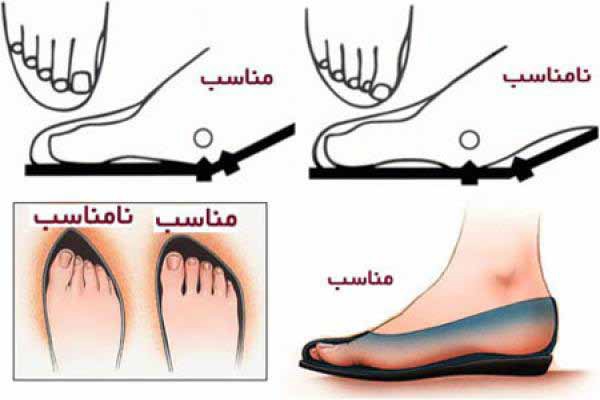
Shoes are the only place where the foot touches the ground while walking, and by choosing a suitable and so-called ergonomic shoe, we can walk more easily and also avoid injuries to the feet (knees and ankles) and especially the back when walking. Avoid prolonged. Legs are our second heart, so wear them properly.
When choosing ergonomic shoes, keep in mind the basic rule that your foot should never match the shape of the shoe. Many people think that shoes should have a narrow heel when they are new because they may “open up” as a result of everyday use. This mistake causes many people to choose tight shoes. In most people, one foot is slightly larger than the other, so be sure to always wear shoes the size of your larger foot. Walk around the store with new shoes and make sure it is comfortable.
If necessary, use a tight insole for the smaller foot and make sure that the shoe should be the same size as your foot and do not buy shoes only on the size written on it. When the ergonomic shoe is on your foot, there should be a distance of at least 0.5-1 cm between the longest toe and the toe, otherwise choose a larger size. When walking, shoes should bend with your feet. In fact, the shoes should cover your feet, not restrict them. The characteristics of a good walking shoe are lightness, flexibility of the shoe in the toe and impact.
The upper of the shoe should be a combination of nylon and leather. This part should always be dry and light and well ventilated. The sole of the shoe should provide good protection for the foot and be padded above the heel. The sole of the shoe should also have two basic properties, the first of which should be shock absorbing while walking and the second should be durable.

Shoes should be such that they do not deform too quickly, as well as the nerves, arteries, muscles, and lymphatics of the foot are not under pressure, and the joints can perform their natural movements easily. A normal foot sweats a little during the day, which causes the soles of the shoes to rot. It is very important to wear each shoe regularly every other day so that each shoe has a day or two to dry and breathe.
If you use insoles, remember to take the insoles out of the shoe every day after removing them to allow them to breathe. Most experts and researchers recommend that when choosing shoes, give priority to the appropriate size, lightness, impact and flexibility, and at the same time take into account all of the above. Ignoring any of the above makes the shoe unsanitary and ergonomic.
Of course, in choosing shoes, one should also pay attention to individual differences such as weight, height and type of skeletal shape. For women, the maximum height of the heel is recommended between 2.5 to 3.5 cm, which if not paid attention to this point leads to many discomforts such as back pain, knee pain and recurrent muscle cramps in the leg area. Care in choosing shoes and paying attention to the principles of standard in its production is one of the most essential needs to maintain people’s health. Most people pay attention to the beauty and color and design of shoes, not to their standard. This puts people’s health at risk in the long run. The choice of shoes in the first place should be based on the type of use that is made of it, and a standard shoe is a shoe that has three distinct characteristics: good material, standard heel and standard mold and toe.
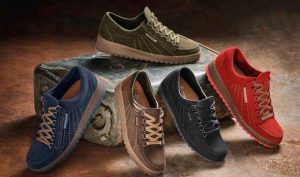
Natural leather, due to the natural pores in its texture, allows the exchange of air between the outside and inside of the shoe and causes the foot to breathe. The air causes bad foot odor and excessive sweating.
There are two types of ergonomic shoe soles on the market: polyurethane (PU) soles and polyvinyl chloride (PVC) soles. PU insoles are lighter, more comfortable, more flexible and more resistant to abrasion, and are more durable. Over time, their friction is slightly reduced and their hardness is lower than that of nitrile rubber. This is why it absorbs pressure shocks. The appearance of these outsoles is solid and they have more flexibility when bending and they enter with the pressure of their fingers. When buying shoes, you should also pay attention to the fact that the sole of the sole should not be flat, but should be treated to prevent slipping.
Paying attention to ergonomic shoe toe standards is also very important in choosing it. In terms of formatting, the toe space of the shoe should be such that it does not put pressure on the toes. Shoes with sharp toes cause the toes to overlap. These shoes put pressure on the toes and deform them. This is more common in women; So that the deviation of the big toe in women is 9 times more than men and the front of the shoe should be such that the toes of the foot are open.
The heel is usually made of leather and rubber so that the upper part is made of leather and the sole is made of soft rubber. Rigid rubber is commonly used for women’s and children’s shoes because they weigh less and do not need to absorb impact like men. It should be noted that the heel with hard rubber increases the durability of the shoe. A wide, low heel increases stability and reduces pressure on the feet, but increasing heel height reduces stability and increases stress on the front of the foot.
The toe of the ergonomic shoe, which is actually the frame on the shoe and encloses the circumference of the foot, easily resists the pressures and maintains the natural condition of the foot.
The human foot is his second heart. Many ancients believed that certain parts of the soles of the feet represented the health of parts of the body and needed a great deal of care. To choose shoes, you should consider the comfort and health of your feet. Comfortable shoes are shoes that have a suitable height and the foot feels comfortable in the shoe. Normally, the sole of the shoe should not be stiff and transfer the pressure to only one point. Equal distribution of body weight to the front and back of the foot is the best form of shoes. However, high heels cause more weight transfer to the front of the foot and it is recommended not to use it for a long time during the day.
Usually, the narrow toe and high heel of the shoe transfer the weight of the body to the front of the foot and deform the toe and protrude the bone of the foot outwards. Continued use of these shoes causes the bone of the foot to contract and the feet to be pulled in the opposite direction. In fact, these abnormalities will cause excruciating pain and will cause the bone of the foot to deform and this deformation will be irreversible. Hence one will have to wear a custom shoe.
Contrary to popular belief, especially women, who consider sandals and slippers to be the most comfortable shoes, suitable shoes are shoes that completely cover the foot, and it is recommended to buy shoes as much as possible in the afternoon when the foot reaches its maximum volume is done.
Because swelling and increase in leg muscle volume in the afternoon is at its greatest. Although most back and leg pain and discomfort is due to inappropriate shoes, only a very small percentage of shoes are ergonomically standard and usually not suitable in terms of material, model, heel placement and weight distribution, but unfortunately most people they use routine shoes.
Ergonomic sneakers or sports-like shoes are the most comfortable shoes, and also leather shoes are the most suitable material for shoes, because the air transfer between the skin and outside the shoes is established.
But shoes that are made of 100% plastic cause sweat on the feet and prevent air flow and cause skin disorders and abnormalities.
Another point is that shoes should not be worn without socks and socks should be made of cotton because it accelerates air transfer. Also, do not put your foot in the shoes for a long time, even shoes that are very comfortable. Flexing and moving the muscles to relieve foot fatigue causes blood to flow to different parts of the foot, this can be pulled up and held at the ankle. Repeating these movements will reduce the swelling that occurs in the legs.
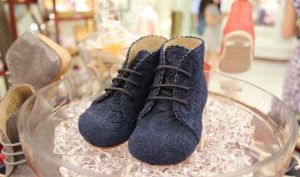
Here are the factors related to standard ergonomic shoes from an ergonomic perspective:
1) A suitable shoe is a shoe that does not put pressure on the foot when worn for a long time.
2) When wearing shoes, keep in mind that your toes do not change position or the sides of your feet are not under pressure from the shoes.
3) Shoes should not only have a beautiful aspect, but should also prevent damage to your feet in any way from heat, cold, forces from the ground and the unevenness of the ground. In this regard, choosing a shoe with a polyurethane (PU) sole and a natural leather upper is appropriate.
4) Considering diseases such as diabetes may limit your choice, but ultimately with the knowledge of the disease and the conditions that govern you, you will make the right choice.
5) During pregnancy, wear shoes that do not put too much pressure on the foot and back area, such as comfortable and flat shoes that have a soft material and texture. Usually during this period, between half to one score, there will be a change in size, according to which a suitable shoe should be selected.
6) If you suffer from frequent low back pain, try to wear medical shoes because these low back pains are sometimes the consequences of wearing inappropriate and non-standard shoes.
7) If you are overweight, wearing flat and comfortable shoes is recommended. Walking in high heels can upset the balance for those who are overweight.
8) Women who are medium or short in height with medium and fat limbs, it is better to use high-heeled shoes with thick and long heels. Of course, the use of needle-heeled shoes is not suitable for these women.
9) The best shoes for walking are shoes that cover the feet well and act as a protector for the foot when walking, and are also flexible so that the foot does not get tired in it. Walking shoes should be so light that you do not feel like you are wearing shoes at all.
10) If you walk professionally and continuously, it is better to choose shoes with legs that do not damage your legs during long walks.
11) Shoes should match the natural shape of your feet. In addition, the arch of the foot should be in line with the arch of the shoe.
12) Flat shoes should be strong and flexible and have a ribbed surface.
13) Avoid wearing high heels for a long time because high heels cause slipping and falling, back and leg pain and changes in foot shape. The heel of the shoe should not be higher than 4 cm. Wider heels are also more suitable than pointed and narrow heels.
14) When wearing shoes, the heels of your feet should not slip inside the shoes.
15) Wearing narrow toe shoes puts pressure on the toes and deforms them.
16) Flat shoes, stilettos or short heels are both more comfortable and safer.
17) Complications of wearing tight shoes include: calluses, corns, joint pains, pain in the knees and heels, and premature fatigue.
18) Wearing loose shoes leads to blisters on the legs and the person does not have enough balance when walking.
19) Choose a shoe that you can change its size slightly, ie shoes with laces or buckles.
20) The lining and cover inside the shoe should be soft, without seams and any protrusions.
21) You are able to get the size of your shoes according to the formula below. First you need to measure the length of your foot, from the tip of the longest toe (usually the big toe) to the back of the heel: Shoe size = foot length (cm) + 2 cm
22) Due to wearing tight shoes, the foot is under pressure and the nervous system is disrupted, and as a result, the power of thinking and decision-making is reduced to a very low level.
In addition to the standard factors related to the material and construction of the shoes, other factors are equally important when buying shoes.
1- The best time to buy shoes is at the end of the day (afternoon), because naturally people’s feet are about half a size smaller in the morning than in the afternoon, and the reason is that your feet get a lot of temperature, pressure and stress during the day. Bear and legs become more swollen and consequently their size becomes larger, so it is a better time in the afternoon to make an informed choice and identify the exact size.
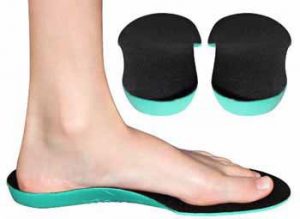
2- In choosing the size of the shoe, two points should be considered, first, in choosing the shoe, it should be worn and relying on the scores written on it is not enough to ensure its size.
Secondly, it should be noted that the size of people’s feet changes with age, weight gain and gain, and even pregnancy, so it is not correct to use the previous sizes in the selection criteria.
3- When buying, it is necessary to wear both soles of shoes, because in most people, the size of one foot is larger than the other, and it is necessary to consider the larger foot as a criterion in choosing shoes.
4- A suitable shoe is a shoe in which the big toe moves easily and there is a distance of about half to one centimeter between the big toe and the front edge of the shoe.
5 – When buying shoes that you plan to wear with socks, it is better to have appropriate socks that are not too thin or too thick.
Another very important point in choosing shoes is that they have heels, which of course is more common in women. “Flat heel” shoes cause heel pain when walking because they do not hit the heel. So there must be heels, but high heels can cause foot pain in another way.
Women are 10 times more likely than men to complain of foot pain due to wearing very high-heeled shoes with sharp toes that put pressure on the toes. Women are advised not to wear shoes that have a heel higher than 3 cm, because the longer the heel of the shoe, the more pressure is placed on the sole of the foot, which is transferred to the front of the foot and finally to the toes, causing injury Reaching the fingers.
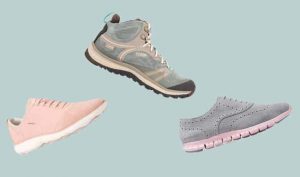
Complications of wearing non-standard high-heeled shoes include big toe deviation, corns, blisters and toe flexion, chronic back pain, joint and knee and heel pain, and premature fatigue.
As the summer season begins and the weather gets warmer, so-called summer shoes or sandals enter the market. The important thing about wearing sandals is that the foot should remain in a fixed position when moving. In shoes with open backs, when moving, energy is spent not to fall out of the foot, and these shoes cause unnecessary fatigue, and also some delicate women’s sandals have a thin strap on the back. Thin straps, due to their small diameter, put more pressure on one point of the foot and cause it pain. Wearing these shoes in the long run is very painful and annoying, so it is recommended that you do not wear sandals at all if you plan to walk longer than 20 minutes.
Children’s growing feet need more protection, and adequate support during this period reduces subsequent foot deformities. The feet of children up to the age of 6 are not yet fully formed, so sufficient care will be necessary. For example, wearing narrow toe shoes for growing children has been shown to have a long-term effect on foot deformities until the bone growth plates are completely closed. Shrinkage of muscles and tendons in children can also be a side effect of inappropriate shoes.
In some countries, children with ankle sprains are wearing high-heeled shoes for 2 to 3 days a week to provide good foot care. Research has shown that children who wear narrow-toed shoes are more likely to develop flat feet. The child’s foot should fit snugly inside the shoe and have a longitudinal arch inside the shoe.
Children use their shoes for various activities, especially games and sports, so it is necessary to buy shoes that are suitable for them when walking normally and during play. For this reason, lace-up shoes are not recommended. Wear high-heeled shoes for newborns. These shoes protect the Achilles tendon and prevent toe twisting. Of course, these shoes are not useful for teenagers and older people.
The edges of children’s shoes should not be rigid and also children’s shoes should not be loose and loose in any way. It should be noted that children’s feet tend to sweat more than adults, so it is recommended for children to use sandals in summer.